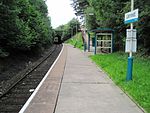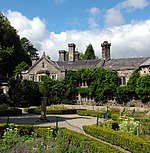Ysgol Dyffryn Conwy
Ysgol Dyffryn Conwy is a bilingual co-educational comprehensive school in the town of Llanrwst in Conwy County Borough, North Wales. The school serves the community of Llanrwst and the many surrounding villages including the rural districts of Betws-y-Coed, Dolgarrog and Cerrigydrudion. There are around 658 pupils on roll, including 137 in the sixth form, which is lower than the figures at the time of the last inspection in 2014. Most of them are bilingual. The school has recently been moved onto one expanded site which had originally housed years 7-9 only. The site of the upper school (the oldest building and site of the original grammar school) has been developed into an NHS centre. The headteacher of the school from 2014–2020 was Elan Davies, the first female headteacher of the school in 400 years.The school was founded as Llanrwst Grammar School in 1610 by Sir John Wynn, which was situated in the building of the 'upper school'. In 1960 it was renamed Ysgol Dyffryn Conwy (Conwy Valley School) to reflect the fact that the school served the wider Conwy Valley. In February 2005 the pupils were all moved to the Sodexo-owned site on Nebo Road.
Excerpt from the Wikipedia article Ysgol Dyffryn Conwy (License: CC BY-SA 3.0, Authors).Ysgol Dyffryn Conwy
School Bank Road,
Geographical coordinates (GPS) Address Nearby Places Show on map
Geographical coordinates (GPS)
| Latitude | Longitude |
|---|---|
| N 53.1392 ° | E -3.7926 ° |
Address
Gwydir GP Surgery
School Bank Road
LL26 0HL , Llanrwst
Wales, United Kingdom
Open on Google Maps








